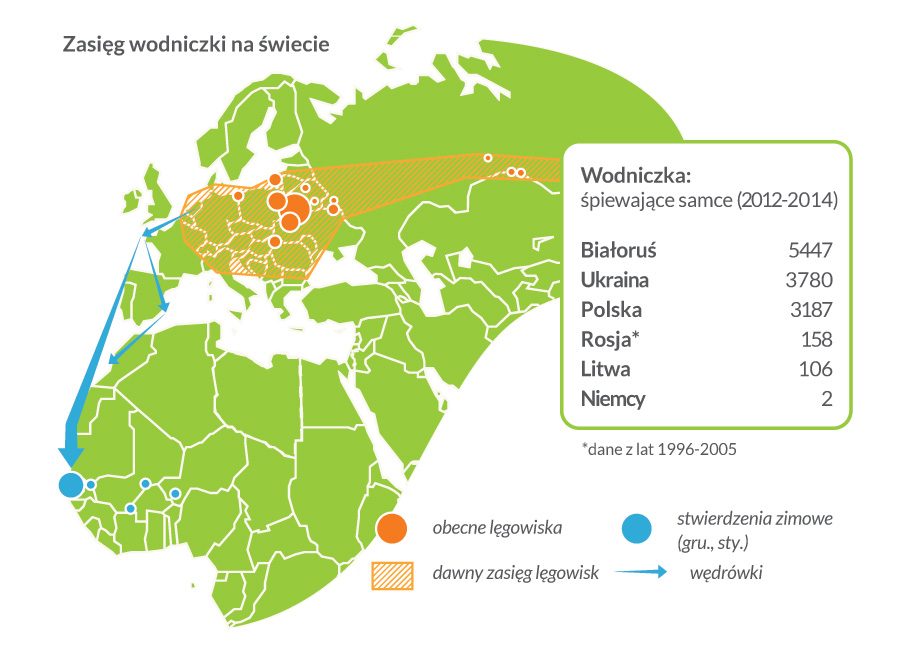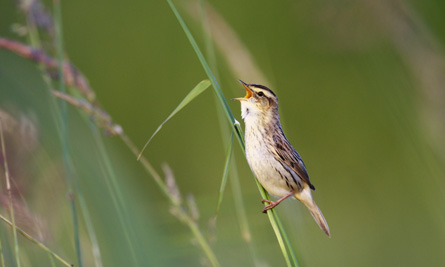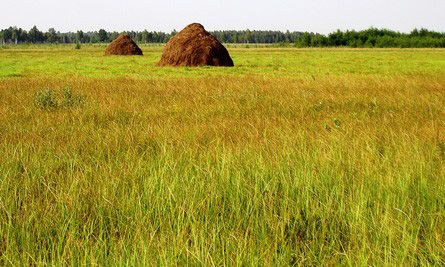With its habitats nowadays dependent on human land use and being extremely susceptible to changes in traditional land use, it is now effectively a conservation dependent species with an acutely threatened and genetically distinct population along the German-Polish border (“Pomerania”) and a larger one in northeastern Poland (“Biebrza region”). A. paludicola is listed in Annex 1 of the EU Birds Directive, and as a priority species for EU LIFE funding.
Most range states including Poland and Germany signed an international Memorandum of Understanding (MoU) on the species under the Bonn Convention for Migratory Species (CMS) in 2003, committing themselves to the implementation of an International Action Plan for this flagship species of its habitat. The proposed project will contribute to its implementation, targeting the breeding sites of 81% of the remaining Polish and German populations in the two named regions (c.2800 pairs), equalling 76% of the EU population.

The breeding range is restricted due to habitat limitations. In the 20th century the species became extinct in Western Europe, and its number drastically decreased in Central Europe. It used to breed in France, Belgium, the Netherlands, former West Germany, former Czechoslovakia, former Yugoslavia, Austria, and Italy.
The species’ characteristics
The sexes are identical in appearance. It is similar to Sedge Warbler, but has a white stripe in the centre of its crown, which is bordered on both sides by black streaks. There is a noticeable white line over the eye. The plumage of the upperparts is brown, but in comparison to Sedge Warbler it is more sandy-coloured and has a more contrasting pattern of dark and bright streaks. The rump has a coppery tinge with brown streaks. The underparts are pale, with a finely streaked breast and sides.
Wodniczka, fot. Alexander Kozulin
Average size:
- length 13 cm (5 in.)
- wingspan 19 cm (7,5 in.)
- weight 12 g
Biotope
The species has very specific habitat requirements. It inhabits fertile peat bogs and extensive marshy meadows covered with sedges and few bushes. It also inhabits areas flooded up to 10-15 cm (4-6 in.) in depth.
Nest
Similar in size and location to that of Sedge Warbler, well concealed in vegetation and always several centimetres above the land or water surface. The male is polygamous and does not take care of the young, this is why some males leave their breeding areas as early as the beginning of July.
Eggs
Very similar to Sedge Warbler. Average size 16×12 mm (0,65×0,5 in.), normally 5 or 6 and laid in the middle of May. Some birds lay a second clutch in June.
Incubation and fledging
Incubation lasts about 14 days after the last egg has been laid. The young leave the nest after 18 days.
Food
Exclusively small invertebrates (mainly spiders and insects).
Protection
A protected species.

Habitat
- Fertile peat bogs with extensive sedge cover near river valley floodlands
Sites with medium and large sedge tussocks, sometimes mixed with Molinia caerulea and short, sparse reeds (Phragmites australis). Sparsely scattered, small bushes, which often constitute the males’ singing posts, are a regular feature of this habitat. This type of habitat is more or less associated with agriculture (burning or mowing of meadows).
- Mesotrophic or slightly eutrophic sedge peat bogs
The principle flora consists of short and medium-sized tussock-forming or erect sedges situated in shallow water (1-10 cm/0,25 – 4 in.). Aquatic Warbler avoids habitats with cottongrass (Eriophorum) and peat moss, and areas where the water is too deep, bushes are too dense and tall or where sedge tussocks are too tall. From an analysis of the location of 92 Aquatic Warbler nests recorded between 1995 and 1997, none were found in areas where the water level was higher than 20 cm (8 in.)
- Cladietum marisci with Cladium mariscus
Here the entire population occurs in Cladium mariscus rush.
- Periodically flooded halophitic communities of the Baltic coast
The principle flora consists of short (80-120 cm/30-47 in.) and sparse reed. Aquatic Warblers have only been found in areas where reed density exceeds 100 stems/square meter. Basically, only areas with young, early succession reed are inhabited. In Polish Pomeranian sites commercial reed cutting provides this type of young reed habitat.
- Marshy meadows covered with tall grasses (Alopecurus pratensis and Phalaris arundinacea) and tussock sedge

Threats
Even though a considerable part of the Aquatic Warbler’s habitats are located within protected areas, many of them are still in danger of degradation. One of the main objectives of OTOP (the Polish Society for the Protection of Birds) is threat identification and protection activities. The main threats to this species’ habitat are:
1. Former, present and planned land reclamation of peat bogs.
Some sites are threatened by low water levels as the result of former land reclamation. A series of ditches can rapidly drain sites, especially during years of limited rainfall. The drained areas are then often rapidly invaded by bushes. For example, the central basin of the Biebrza river, the Narew and Chełm. There has also been some recent land reclamation works in two areas of the Szkwa River valley (Łyse district, Ostrołęckie province). One of the areas in which the works have been conducted was reported as supporting about 10 singing male Aquatic Warblers in 1995. Both areas have been drained on a large scale which has resulted in highly unfavourable changes in Aquatic Warbler habitat. No Aquatic Warblers have been reported in any of the areas since 1997.
2. Habitat changes due to the cessation of meadow management.
There is no meadow management in several areas, with meadows not being mown for several years and only irregular grass and reed burning. This results in succession. Initially the wet sedge areas become isolated and dominated by Phalaris arundinaceus and Glyceria maxima. Then seedlings of trees appear and gradually overgrow the unmanaged areas (for example Pomerania and Narew).
3. Habitat changes due to uncontrolled burning.
This is especially damaging during dry summers. The burned sedges are replaced by grass communities together with Molinia caerulea and quickly become overgrown by bushes (for example Chełm and Biebrza).
4. Too intensive agriculture.
-
Commercial sedge mowing (Pomerania) leading to a change from sedge areas to reed plantation. Even if reed mowing is carried out in areas close to Aquatic Warbler sites, it is possible that the sites may be used for machinery access or for storage of mown reed. Mowing in late May has also been recorded which is in complete contravention of existing regulations!
-
The main threat for Aquatic Warbler is the complete and almost simultaneous mowing of whole meadows in certain areas (e.g. the valley of the river Narew, the Wizna marshes). This usually occurs during the last days of June and in early July which coincides with the Aquatic Warbler’s second breeding period.
-
There is also the risk of privatization that could lead to exploitation of areas (for example the Wizna marshes). There are plans to return 900 ha of reed back to their former owners.
According to the Agricultural Property Agency, the remaining part is to be sold or added to the Biebrza National Park.
5. The development of transportation networks and agricultural buildings in the immediate vicinity of Aquatic Warbler sites.
This concerns those Aquatic Warbler sites which are not included in effective environmental protection schemes (Nature reserves, National Parks). On the marshes around Chełm there have been no protection areas established although they were identified and proposed whilst making a nature inventory as early as 1993. Additionally, the National Park’s borders follow the border of the nature reserve, and therefore there are no buffer zones around the areas. There are plans to construct an express ring road around Chełm in the immediate vicinity of two nature reserves – Brzeźno and Serebryskie Marshes. Among the direct threats are: loss of agricultural and wooded areas to associated facilities i.e. technical and service facilities; noise, air and soil pollution; increased urbanization, and increased disturbance and trespass. Roskosz Natural Reserve is situated in the vicinity of the main road from Chełm to Dorohusk (an international border crossing with a steadily increasing level of road traffic). Inevitably, different kinds of buildings will be constructed along the route. There is a railway in the immediate vicinity of the route and trans-shipments take place on a northern loading ramp which cuts into the marsh.
Identifying Aquatic Warbler, Sedge Warbler, and Fan-tailed Warbler
At first glance Aquatic Warbler and Sedge Warbler might seem identical but under closer scrutiny (using binoculars!) and with a knowledge of their distinctive features, it is not difficult to correctly separate the two species. The differences in voice are an essential element of recognition. Moreover, habitat characteristics can be an additional tip. Below are the features that separate Aquatic and Sedge Warblers. Not every feature can be seen right away. Some of them are only visible in fresh plumage, others (e.g. wing dimensions) are given only for information because they cannot be precisely assessed in the field. However, they may be of use while examining a caught (only for the purposes of ringing!) or dead bird.
- Shape. Fractionally smaller than Sedge Warbler (wing length 57-68 mm/2,2-2,7 in.); slightly more slender; the head appears smaller and more rounded; the neck often appears longer; while perched it adopts a more upright pose with outstretched legs and lifted head. It often cranes its neck striking an ungainly pose (Sedge Warbler does not behave in such a way).
- Upperparts. Yellow-beige to golden, with colours more intense in young birds which can also have a brown-beige tone. In adult birds, especially during the spring and summer when the feathers are faded and worn, the plumage tone becomes greyer and the warm colours and golden shade are less intense.
- Head. In the centre of the crown there is a stripe, which is usually wide, as with the eyebrow (supercilium), straw-coloured, though may sometimes look white, strongly contrasting and is bordered by black lines which widen behind the eye. The mid-crown stripe is clearly visible when one looks at the bird’s head from the front or back. In profile it may be very difficult to see. The eyebrow is bright yellow-beige, sometimes with a reddish tint, and wider behind the eye. The head stripe and eyebrows may have a reddish tint next to the beak and a darker spot in front of the eye, but the lores are usually bright, greyish, rarely with a distinctive dark line (adult birds in autumn). The stripe behind the eye is black, wide, and bends down along the rear edge of the ear coverts. The beak, which is noticably bright, varies from yellowish to pale pink, with only the upper part of the upper mandible being darker; the inside of the mouth is yellow in fledged birds.
- Neck/mantle. Very contrasting with black and bright yellowish-beige stripes. In adult birds, when feathers are faded and worn (especially in spring and summer) the colouring may change to blackish with grey-white narrow stripes, but at least two contrasting bright (white) stripes are always visible. The rump and upper tail coverts are always clearly streaked, with the longitudinal stripes becoming more dense nearer to the tail.
- Wing. Slightly brighter and more reddish than the rest of the upperparts, with clearly defined edges to the tertials.
- Tail. Slightly graded (8-12 mm/3-5 in. difference between the shortest and longest tail coverts; the tail coverts are slightly narrower and less pointed (this feature can easily be seen on photographs, in the field it is very difficult to see), so the spread tail may appear to be ragged.
- Underparts. Whitish, with a more or less intense reddish-yellow wash that intensifies towards the tail; the sides of the breast (sometimes all of it) and the flanks are clearly and finely streaked; the streaks become longer and clearer towards the rear. In some adult birds the streaks may be very clear. In juveniles the streaks are less numerous and pronounced and may sometimes be absent.
- Legs. Bright, pink to yellowish-flesh coloured.
- Voice. Distinctly different to Sedge Warbler; very simple and unlike other national (Polish) Acrocephalus warblers. It usually lasts for 1-2 seconds, beginning with a dry, toneless rattle, after which there is a short series of squeaking notes that consists of two, three (rarely several) syllables – ‘trrtrtr-ji-ji’, ‘trrt-di-di-di’, ‘errr-dju-dju-dju’. When the male sings while performing a nuptial display, the song may have more syllables and last longer (up to 8 seconds).
Good recordings of Aquatic Warbler song can be found on the recordings of “Głosy ptaków Polski” (Bird Songs of Poland) Z. Pałczyński, 2001, “Ptaki doliny Biebrzy”(Birds of the Biebrza Valley) Z. Pałczyński. 1999, and on an audio cassette “Ptaki wodno-błotne” (Marsh Birds and Waterfowl) Z. Pałczyński, 1994. Aquatic Warbler
- Shape. Imperceptibly larger (wing length 59-72 mm/2,3-2,8 in.) than Aquatic Warbler; the head appears to be bigger and the neck longer. While perched it rarely raises itself on its legs, more frequently adopting a horizontal position, and rarely raises its head which is usually kept “between the shoulders”, making the neck look shorter or even disappearing.
- Upperparts. Olive-beige or cinnamon-beige, warmer and more intense in young birds. In adult birds, especially during late spring and summer, when feathers are faded and worn, the plumage’s tone becomes grey, with the warm and yellow-beige colours less intense. The plumage sometimes looks uniformly dark (dark brown) and the paler elements become almost white.
- Head. In the centre of the dark-brown or blackish crown there is an indistinct beige stripe, densely and unevenly streaked, sometimes (especially in young birds), it is wide and clearer but it is never as contrasting and clear as in Aquatic Warbler. All of the top of the head is sometimes dark, with four thin, more or less evenly spaced rows of paler lines. The eyebrow (supercilium) is bright- yellow-beige to whitish, widening behind the eye, and it is usually shorter than in Aquatic Warbler reaching to the rear edge of the ear coverts. The lores always have a dark (brown-grey to blackish) streak; the stripe behind the eye is dark-brown, narrow and blurred on the upper part of the ear coverts and rarely extends to the rear edge. From the corner of the beak there is a short, grey-beige, indistinctly outlined line that contrasts with the wide and bright mark near the eye.
- Beak. Distinctly dark. Only the tip of the mandible is bright, yellowish; the inside of the mouth of fledged birds is orange to tin-brown-orange.
- Neck/mantle. Uniformly coloured, sometimes almost evenly grey-brown-beige, most frequently yellow-beige, indistinctly grey-brown, spotted; the rows of spots may form blurred streaks and there are never two clear bright streaks as in Aquatic Warbler.
- Rump and upper tail coverts. Usually uniformly coloured, occasionally with visible darker grey-brown patterning along the feather shafts, but never as contrasting as in Aquatic Warbler.
- Wings. Slightly darker and more brown-beige than Aquatic Warbler, with less contrasting edges to the tertials.
- Tail. Less rounded than Aquatic Warbler (4-8 mm/1.5-3 in. difference between the shortest and the longest tail coverts); the tail coverts are slightly wider and unpointed.
- Underparts. Whitish, with a more or less intense beige wash that intensifies on the flanks. The upper parts of the breast (often the sides) may have very pale, small grey or brown spots (never streaks) usually only in juveniles, the flanks are always plain and unstreaked.
- Legs. Usually darker than Aquatic Warbler, grey-greenish to yellow-grey.
- Voice. Distinctly different to Aquatic Warbler (although some similar notes can be heard – clatters and squeals) being complicated and varied, similar to other species of Acrocephalus warblers. It usually contains imitations of other birds’ songs. A verse usually lasts for 20 seconds (therefore longer than typical Aquatic Warbler), and consists of many varied elements and has no repetitive pattern that could be termed as characteristic.
Fan-tailed Warbler
This is a bird similar to Aquatic Warbler and Sedge Warbler, which also occurs in the south of Europe, with Hungary and Ukraine being the closest sites to Poland.
It can be distinguished by the tone of the plumage – darker, warmer, brownish-red (not straw-coloured, yellowish or greyish), easily visible, especially on the upperparts and sides of the bird. The plumage is more contrasting than Sedge Warbler but less streaked than Aquatic Warbler. Neck/mantle. This has rows of blurred dark spots but lacks the two bright and contrasting streaks found in Aquatic Warbler. The head patterning almost appears to be black and white. The top of the head is darker than Aquatic Warbler (although there can be indistinct bright lines in the centre). A darker streak on the crown, as in Aquatic Warbler, is never present. The eyebrow (supercilium) is wide (bright beige, creamy or whitish), more contrasting than Sedge Warbler, ending sharply at the edge of the ear coverts, this is narrower than in Sedge Warbler, not so contrastingly bright and is always smoothly blurred towards the rear. In Aquatic Warbler it is reddish at the front and longer, reaching to the edge of the ear coverts. The blackish streak through the eye is narrow and contrasts sharply with the eyebrow. The ear coverts are brown, darker than in Aquatic and Sedge Warblers, highlighted at the bottom by a thin dark line. The throat is white. There is a reddish band on the upper part of the breast, often incomplete being broken in the middle, that can have small dark streaks. The wing length is a crucial feature for distinguishing Fan-tailed Warbler. It is distinctily shorter with the primaries extending beyond the tertials for about 1/3 of their length (it is ¾ length of the tertials in Sedge Warbler). The tail is slightly longer than Sedge Warbler is clearly graded and often cocked upwards. The legs are dark.
Voice. Harsh, tapping ‘shak-shak’; when the bird is flying, a long, energetic rolling ‘trrrrrr’ can be heard. The song is varied, similar to Reed Warbler, but almost with no grinding or cluttering elements, it does contain however, flute-like ‘lj-lj-lj-lj…’ or ‘dji-dji-dji-..’ similar to the notes of Nightingale or Woodlark.
Paying close attention to habitat characteristics is very important when distinguishing Aquatic from Sedge Warbler. Aquatic Warbler is associated with boggy, marshy meadows with sparse, single bushy willows, sometimes with sparse reeds. Sedge Warbler, however, lives in areas with dense bushes (bushy willows) and reeds on the edges of marshes where Aquatic Warbler can only be seen during migration, i.e. from mid April to mid May and from mid July to mid October. Sedge Warbler does not occur in meadows completely devoid of bushes and on “open” marshes, but it readily occurs on the edges of marshy areas and water bodies overgrown with bushes and tall herbaceous plants (reeds, grasses, sedges). If it occurs alongside Aquatic Warbler it is usually confined to bushes and taller thickets from where it sings.
Finding Aquatic Warblers is not a difficult task, but may take a lot of time. One needs to pay attention to the habitat’s appearance, and concentrate where it is more likely that Aquatic Warbler will occur. It should be a marshy meadow (flooded to a depth of a few centimetres in spring) overgrown with tall tussocks of sedge with no other plants, or a meadow with sparse reed. This kind of meadow may be also covered by Cladium mariscus (a kind of grass a bit similar to reed).
During the breeding season Aquatic Warbler never occurs in dense stands of tall reed (it may, however, be found there during migration). It usually avoids places that have dense bushes, although single willows are not an obstacle. To find Aquatic Warbler one needs to be in an appropriate habitat and listen out for the male’s song – it is much more difficult to see a bird than to hear it, and it needs more time (observation is usually a confirmation of finding and recognizing the call). It is very difficult to find a female because they are rarely heard and the call is not characteristic. Females also usually remain hidden in the vegetation.
The bird can sometimes be heard during the day but the peak of activity begins at dusk, when all of the males sing simultaneously and continue until darkness falls. This time – from sunset to nightfall – is the most convenient for detecting and counting the males of Aquatic Warbler. At this time (after sunset) it is rare for Aquatic Warblers to perform nuptial displays but they sing while sitting, quite often clearly visible, on a plant that extends above the surrounding meadow vegetation.
During the day, in bad weather conditions (cold, strong wind) Aquatic Warblers may not be heard for 20-40 minutes and sing only single verses of song or make just a short rattle. Birds may not be visible at this time and are unlikely to perform nuptial displays. When the weather is hot and sunny birds sing several times for several minutes, even at noon. It usually takes 5-20 minutes to detect a singing male during the day (30-60 minutes when the weather is worse). The male may sing hidden in sedge (especially when the weather is windy) but will readily sit on taller stalks, weeds that jut out above a meadow or on the side branches and tops of bushes. Irregularly (but sometimes every few or even several times a minute) a male performs a nuptial display flight while giving a prolonged song. During the nuptial display, the male flies to a height of 5 metres (16,5 ft) or more, starts to sing and glides down with spread wings, raised head and lifted tail. Having ended its song, the bird quickly hides in bushes. Sedge Warbler performs a similar flight, but it is usually done over bushes or taller scrub, not over the open space of a meadow.
Written by: Tomasz Cofta
Aquatic Warbler song
Adam Mickiewicz University, Poznań, Poland

